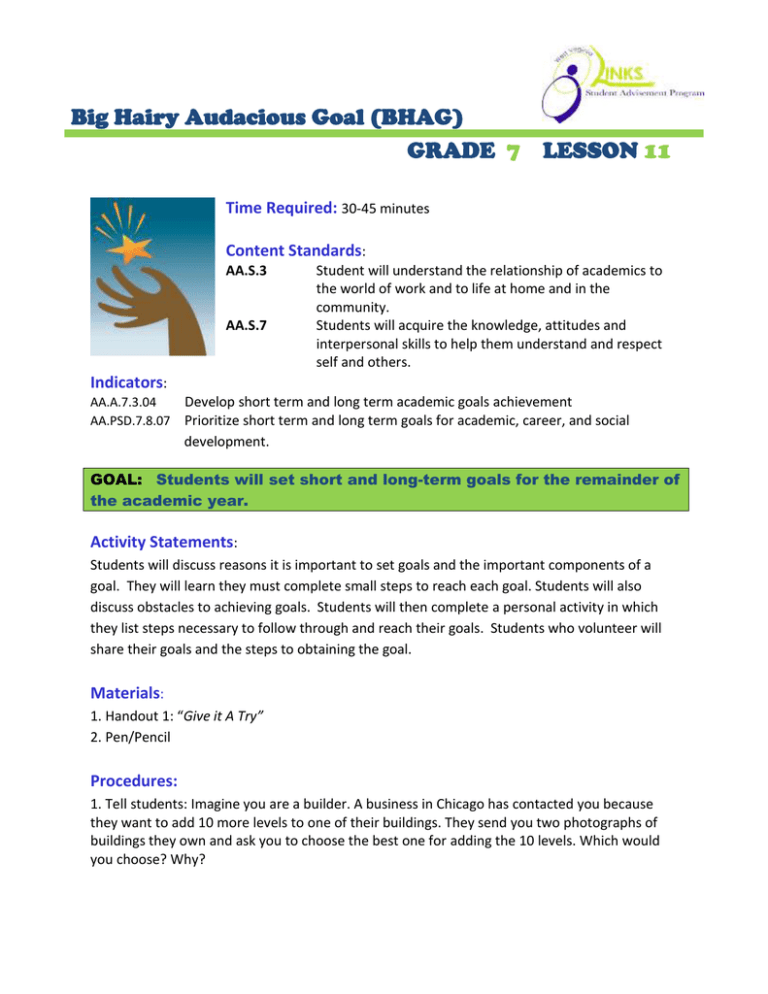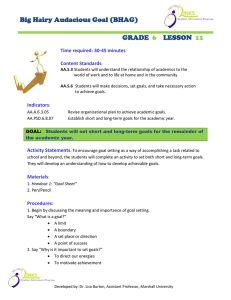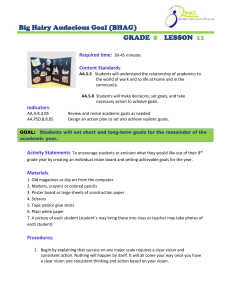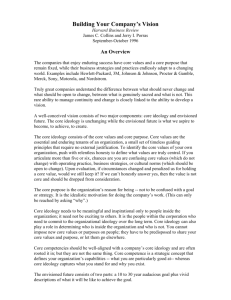Big Hairy Audacious Goal (BHAG) GRADE LESSON
advertisement

Big Hairy Audacious Goal (BHAG) GRADE 7 LESSON 11 Time Required: 30-45 minutes Content Standards: AA.S.3 AA.S.7 Student will understand the relationship of academics to the world of work and to life at home and in the community. Students will acquire the knowledge, attitudes and interpersonal skills to help them understand and respect self and others. Indicators: AA.A.7.3.04 AA.PSD.7.8.07 Develop short term and long term academic goals achievement Prioritize short term and long term goals for academic, career, and social development. GOAL: Students will set short and long-term goals for the remainder of the academic year. Activity Statements: Students will discuss reasons it is important to set goals and the important components of a goal. They will learn they must complete small steps to reach each goal. Students will also discuss obstacles to achieving goals. Students will then complete a personal activity in which they list steps necessary to follow through and reach their goals. Students who volunteer will share their goals and the steps to obtaining the goal. Materials: 1. Handout 1: “Give it A Try” 2. Pen/Pencil Procedures: 1. Tell students: Imagine you are a builder. A business in Chicago has contacted you because they want to add 10 more levels to one of their buildings. They send you two photographs of buildings they own and ask you to choose the best one for adding the 10 levels. Which would you choose? Why? Big Hairy Audacious Goal (BHAG) GRADE 7 LESSON 11 2. In addition, you’d likely choose the one with the best foundation—the one that gives your new addition the best opportunity to succeed. Your life is not so different from this example. Right now in middle school, you are making choices that are forming the foundation for your future. For example: “Should I study for my math test or watch TV?” “Should I cheat on my history exam?” “Should I hang around with those people even though they get me in trouble?” “Should I work hard in school or just try to get by?” 3. Tell students “Today’s choices are the foundation for tomorrow’s options.” 4. One key to making good choices today as you build your foundation is setting goals about what you want in the future. Keith Ellis wrote a book entitled The Magic Lamp: Goal Setting for People Who Hate Setting Goals. “The real trick is figuring out what you want,” Ellis writes. “Strangely enough, people don’t usually get what they want from life because they don’t know what they want.” 5. Give students the following example: Setting Goals Say “The goals that you have for your future guide the choices that you make. Here’s how simple goal-setting can be”. Example: Goal: I want to improve my history grade from a B to an A. By when? End of this year Steps: 1. Tell my teacher about this goal and ask for her advice By when? November 1 2. Study history every Monday, Tuesday, and Wednesday night By when? Ongoing from 7:00– 8:00 6. Next, indicate that in this session you are going to work on short- and long-range goals or what we like to call “Big Hairy Audacious Goals – BHAG”. 7. Give students Handout 1: Give it a Try and ask students to complete. Have students discuss their goals with the class when completed. Discuss if the goals are controllable, possible, measurable, conceivable, and definite. If not, have students revise as necessary. Discussion: 1. Why is it important to set goals? 2. Are there some famous people you know that might use goal setting to help them? Who are they? Why would they have goals? Developed by: Dr. Lisa Burton, Assistant Professor, Marshall University (Dec., 2009) Big Hairy Audacious Goal (BHAG) GRADE 7 LESSON 11 3. How does setting goals help you in school? At home? 4. Describe how it feels when you achieve or accomplish a goal? 5. If there are obstacles in your way that interfere with achieving your goal, what can you do? 6. What resources can you use to help achieve your goal? Additional Resources: Articles and ideas for setting and keeping goals www.kidshealth.org Resource about goals setting http://www.cfnc.org/static/pdf/home/sc/curriculum/student_act-7th_g.pdf Extension Activities: Students: Ask each student to take their completed Give it a Try home and share it with their parents or guardians. Suggest they keep track of their improvements, analyze the plan frequently, and make changes if the plan is not going well. Advisors: Set a definite time for the report-in on goal achievement. The review will include progress on the goal and resetting goals which were not accomplished. Review the criteria for a good goal. Be sure new goals meet those criteria. Developed by: Dr. Lisa Burton, Assistant Professor, Marshall University (Dec., 2009)






